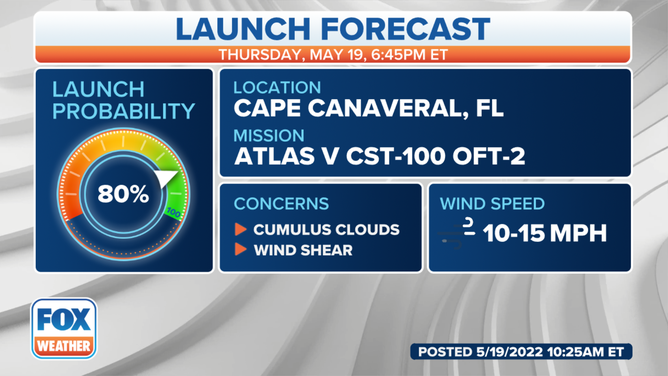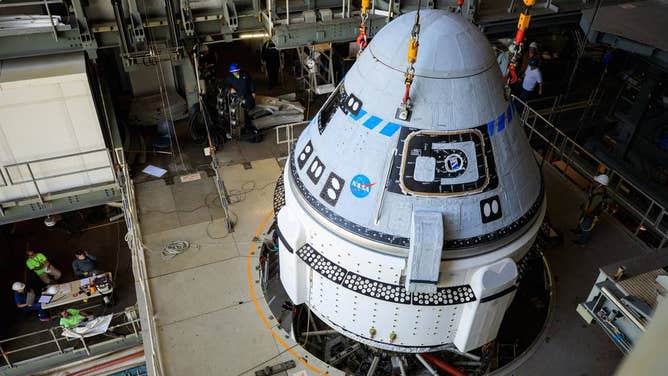Boeing Starliner countdown underway in Florida
6:54 p.m. ET Thursday liftoff will send Starliner to the space station
CAPE CANAVERAL, Fla. – Boeing and United Launch Alliance continue to move forward with Thursday evening's launch to complete the final test needed before Boeing's CST-100 Starliner spacecraft can fly astronauts to the International Space Station.
On Wednesday, teams rolled the 172-foot-tall ULA Atlas V rocket and Starliner from the hangar to the launchpad, Space Launch Complex-41, at Cape Canaveral Space Force Station. After the 1,800-foot journey, the vehicle was prepped for lift-off and fueling could begin.
On Thursday, the countdown was underway and the rocket was fueled with 66,000 gallons of super-cold propellant. ULA officials said countdown operations were going smoothly.
HOW TO WATCH FOX WEATHER ON TV

The United Launch Alliance Atlas V rocket and Boeing's Starliner spacecraft at Launch Complex-41 at Cape Canaveral Space Force Station in Florida. (Image: ULA)
The rocket is scheduled to lift off Thursday at 6:54 p.m. ET, sending the Starliner on its journey to the space station.
No one will be on board this flight, but the Orbital Flight Test-2 is the final step before a test flight with astronauts later this year. The spacecraft's commander seat will have a manikin named "Rosie the Rocketeer." Her seat will be outfitted with sensors to collect data and better understand what human astronauts will experience.
HOW EXTREME HEAT CAN AFFECT AIR TRAVEL
NASA astronaut Butch Wilmore said the astronauts who have been training to fly on Starliner are jealous of the manikin that gets to take the trip.
"But obviously, this is part of the evolution of test," Fincke said. "We need to go up, fly the spacecraft without humans on it, demonstrate the automated systems and come back safely … we're thrilled for this because the next one is us."

Atlas V Boeing Starliner launch forecast for May 19, 2022.
(FOX Weather)
On launch day, forecasters with the Space Force 45th Weather Squadron predict a 90% chance of favorable weather for liftoff.
An isolated shower and cloud cover can't be ruled out as Florida's rainy season is underway. The primary concerns for the instant launch window will include the Cumulus Cloud and the Anvil Cloud Rules.
About an hour ahead of launch, a thick haze surrounded the Cape but cloud cover developing in the area actually improved the launch conditions, according to Brian Cizek, with the 45th Weather Squadron. The high cloud cover helped to limit the hitting in the area preventing thunderstorms coverage in the area.
MEET THE MANIKINS THAT WILL HITCH A RIDE ON NASA’S MOON ROCKET
If the launch delays to Friday's backup window, weather conditions will deteriorate as winds push moisture up from the Caribbean increasing rain and cloud cover concerns.
Starliner will dock at the ISS around 7 p.m. Friday or about 24 hours after launch if all goes well.
This will be Boeing's third attempt to complete the orbital flight test since 2019.
In 2014, NASA selected SpaceX and Boeing to develop spacecraft to shuttle astronauts to and from the ISS under the agency's Commercial Crew Program.
Both Boeing and SpaceX agreed to complete uncrewed flight tests to the ISS before flying humans. SpaceX's Crew Dragon spacecraft recently launched its fourth long-term mission with NASA astronauts. In February, the agency bought three more commercial crew missions from SpaceX for $3 billion.
Boeing's first attempt to complete the OFT in 2019 ended 48 hours after launch due to a computer glitch.
HOW HEAVY IS IT REALLY GOING TO RAIN?
Another try in August 2021 was called off before launching when engineers discovered that valves on the spacecraft were sticking due to an issue caused by humidity and fuel. Last week, a report by Reuters revealed Boeing and the manufacturer of the valves, Aerojet Rocketdyne, are in dispute over the issue.

The Boeing CST-100 Starliner spacecraft is lifted at the Vertical Integration Facility at Space Launch Complex-41 at Cape Canaveral Space Force Station in Florida on May 4, 2022, ahead of its second Orbital Flight Test (OFT-2) to the International Space Station for NASA's Commercial Crew Program. Credits: NASA/Frank Michaux
Despite the missteps, NASA managers and astronauts are confident in the spacecraft and say it's essential to have a second human-rated spacecraft.
The final crew assignment for Starliner's first human spaceflight is to be determined. Wilmore, along with NASA Astronauts Suni Williams and Mike Fincke, have all been training to fly on Starliner. Astronauts Nicole Mann and Josh Cassada were assigned to fly on Starliner, but after delays will now fly on SpaceX's fifth mission for NASA, Crew-5.
Williams said the astronaut corps are chomping at the bit to have another spacecraft to fly.
"One of the things that Rosie doesn't do, she doesn't breathe, and so we'll be the first ones when we get in to be the breathers, the creators of carbon dioxide," Williams said.